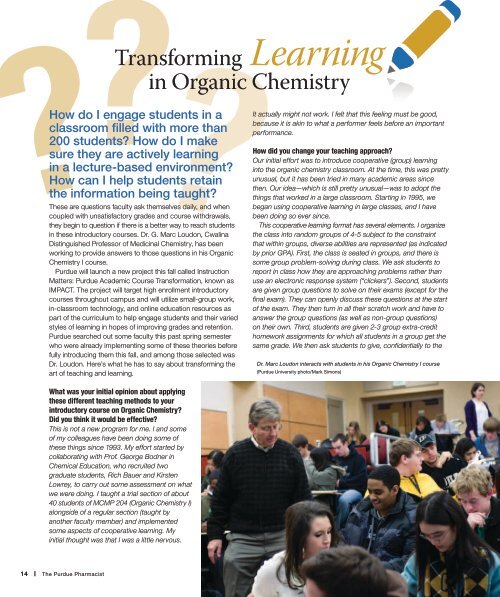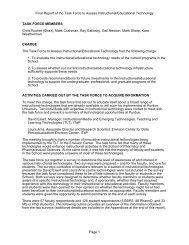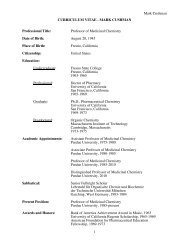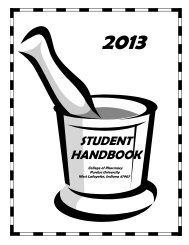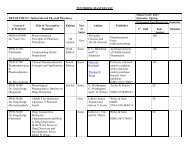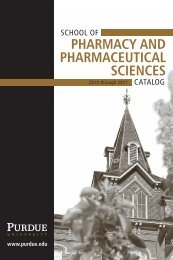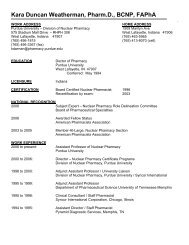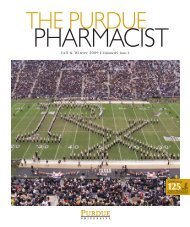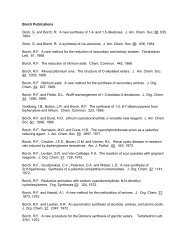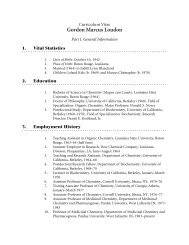Spring/Summer 2011 - Purdue College of Pharmacy - Purdue ...
Spring/Summer 2011 - Purdue College of Pharmacy - Purdue ...
Spring/Summer 2011 - Purdue College of Pharmacy - Purdue ...
Create successful ePaper yourself
Turn your PDF publications into a flip-book with our unique Google optimized e-Paper software.
???<br />
Transforming Learning<br />
in Organic Chemistry<br />
How do I engage students in a<br />
classroom filled with more than<br />
200 students? How do I make<br />
sure they are actively learning<br />
in a lecture-based environment?<br />
How can I help students retain<br />
the information being taught?<br />
These are questions faculty ask themselves daily, and when<br />
coupled with unsatisfactory grades and course withdrawals,<br />
they begin to question if there is a better way to reach students<br />
in these introductory courses. Dr. G. Marc Loudon, Cwalina<br />
Distinguished Pr<strong>of</strong>essor <strong>of</strong> Medicinal Chemistry, has been<br />
working to provide answers to those questions in his Organic<br />
Chemistry I course.<br />
<strong>Purdue</strong> will launch a new project this fall called Instruction<br />
Matters: <strong>Purdue</strong> Academic Course Transformation, known as<br />
IMPACT. The project will target high enrollment introductory<br />
courses throughout campus and will utilize small-group work,<br />
in-classroom technology, and online education resources as<br />
part <strong>of</strong> the curriculum to help engage students and their varied<br />
styles <strong>of</strong> learning in hopes <strong>of</strong> improving grades and retention.<br />
<strong>Purdue</strong> searched out some faculty this past spring semester<br />
who were already implementing some <strong>of</strong> these theories before<br />
fully introducing them this fall, and among those selected was<br />
Dr. Loudon. Here’s what he has to say about transforming the<br />
art <strong>of</strong> teaching and learning.<br />
What was your initial opinion about applying<br />
these different teaching methods to your<br />
introductory course on Organic Chemistry?<br />
Did you think it would be effective?<br />
This is not a new program for me. I and some<br />
<strong>of</strong> my colleagues have been doing some <strong>of</strong><br />
these things since 1993. My effort started by<br />
collaborating with Pr<strong>of</strong>. George Bodner in<br />
Chemical Education, who recruited two<br />
graduate students, Rich Bauer and Kirsten<br />
Lowrey, to carry out some assessment on what<br />
we were doing. I taught a trial section <strong>of</strong> about<br />
40 students <strong>of</strong> MCMP 204 (Organic Chemistry I)<br />
alongside <strong>of</strong> a regular section (taught by<br />
another faculty member) and implemented<br />
some aspects <strong>of</strong> cooperative learning. My<br />
initial thought was that I was a little nervous.<br />
It actually might not work. I felt that this feeling must be good,<br />
because it is akin to what a performer feels before an important<br />
performance.<br />
How did you change your teaching approach?<br />
Our initial effort was to introduce cooperative (group) learning<br />
into the organic chemistry classroom. At the time, this was pretty<br />
unusual, but it has been tried in many academic areas since<br />
then. Our idea—which is still pretty unusual—was to adopt the<br />
things that worked in a large classroom. Starting in 1995, we<br />
began using cooperative learning in large classes, and I have<br />
been doing so ever since.<br />
This cooperative learning format has several elements. I organize<br />
the class into random groups <strong>of</strong> 4-5 subject to the constraint<br />
that within groups, diverse abilities are represented (as indicated<br />
by prior GPA). First, the class is seated in groups, and there is<br />
some group problem-solving during class. We ask students to<br />
report in class how they are approaching problems rather than<br />
use an electronic response system (“clickers”). Second, students<br />
are given group questions to solve on their exams (except for the<br />
final exam). They can openly discuss these questions at the start<br />
<strong>of</strong> the exam. They then turn in all their scratch work and have to<br />
answer the group questions (as well as non-group questions)<br />
on their own. Third, students are given 2-3 group extra-credit<br />
homework assignments for which all students in a group get the<br />
same grade. We then ask students to give, confidentially to the<br />
Dr. Marc Loudon interacts with students in his Organic Chemistry I course<br />
(<strong>Purdue</strong> University photo/Mark Simons)<br />
14 The <strong>Purdue</strong> Pharmacist


